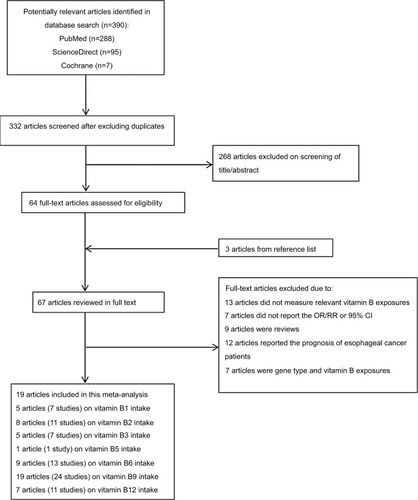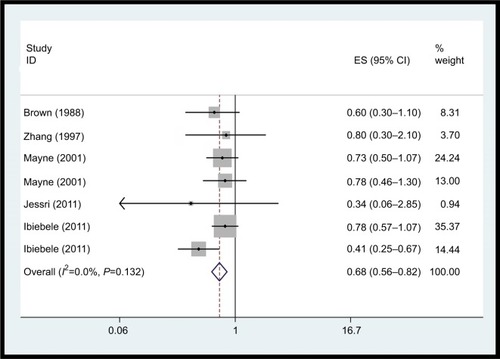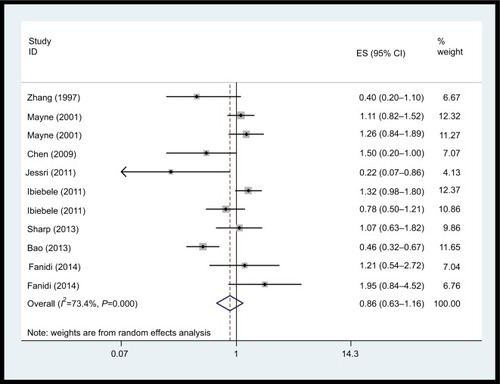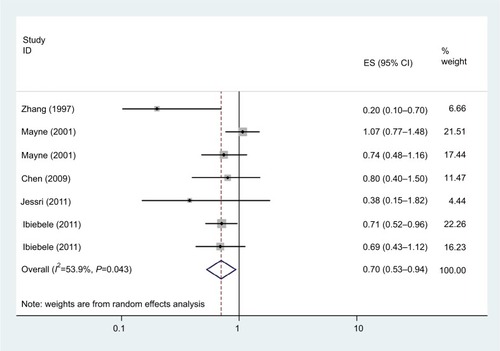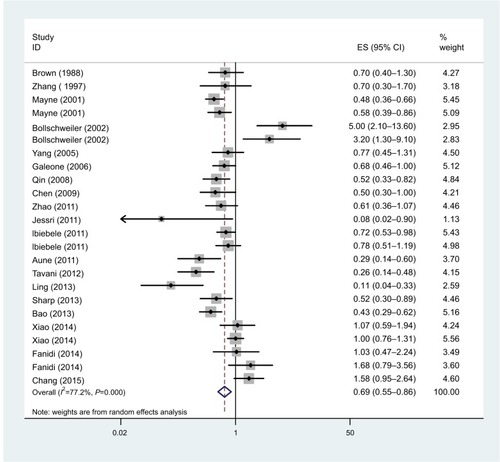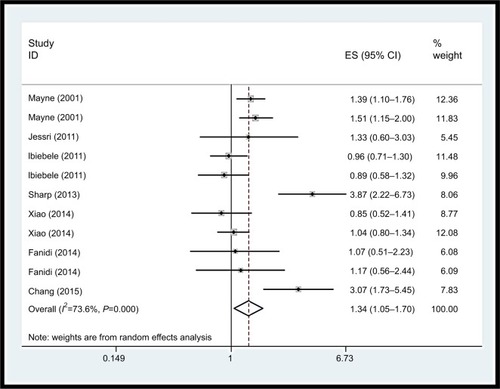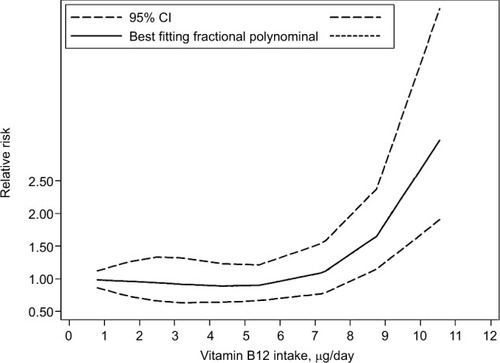Abstract
Background
Several epidemiology studies have explored the association between dietary B vitamins’ intake and the risk of esophageal cancer (EC). However, the results remain inconclusive. Thus, we conducted a systematic review with meta-analysis to evaluate such association.
Methods
Literature retrieval was performed using PubMed (Medline), ScienceDirect, and Cochrane Library electronic databases for all studies published from database inception to December 2017.
Results
The meta-analysis included 19 studies and showed an overall decreased risk of EC (OR=0.77, 95% CI: 0.68–0.87) in association with multivitamin B (ie, B1, B2, B3, B5, B6, B9, and B12) dietary intake. In a subgroup analysis based on vitamin B subclass, B1, B3, B6, and B9 vitamins were associated with decreased EC risk (vitamin B1: OR=0.68, 95% CI: 0.56–0.82; vitamin B3: OR=0.70, 95% CI: 0.53–0.94; vitamin B6: OR=0.64, 95% CI: 0.49–0.83; and vitamin B9: OR=0.69, 95% CI: 0.55–0.86). By contrast, no association was detected between dietary vitamin B2 and vitamin B5 intake and EC risk (vitamin B2: OR=0.86, 95% CI: 0.64–1.16; vitamin B5: OR=0.49, 95% CI: 0.20–1.20), whereas a potential non-linear dose–response association was found between dietary vitamin B12 intake and EC risk. A statistically significant, inverse association was observed for an increase of 100 µg/day in supplemental vitamin B6 and B9 and EC risk (vitamin B6: OR=0.98, 95% CI: 0.98–0.99; vitamin B9: OR= 0.89; 95% CI: 0.86–0.94).
Conclusion
These findings support that vitamin B may have an influence on carcinogenesis of the esophagus. Vitamin B1, B3, B6, B9 showed a decreased risk of EC, and vitamin B12 showed an increased risk of EC.
Keywords:
Introduction
Esophageal cancer (EC) has been ranked as the eighth most common cancer and the sixth leading cause of cancer-related deaths worldwide.Citation1 Its epidemiology varies widely, particularly in incidence rates among geographic regions.Citation2 The latest epidemiological studies indicated the highest rate of EC located on the “esophageal cancer belt” ie, China, South Africa, and France.Citation3,Citation4 Possible risk factors for EC include alcohol drinking, hot-temperature food items, cigarette smoking, chronic mucosal irritation, and a family history of cancers.Citation5–Citation7 Deficiency of nutrients, such as vitamins and micro-elements, was also found to be associated with an increased risk of EC, whereas a high intake of fruit and vegetables has been considered to be effective in prevention.Citation6 Several previous research studies have evaluated the effect of beta-carotene, vitamin A, C, and E on EC.Citation8–Citation17 Regarding multivitamin B, most studies only examined folate intake and EC risk, and no relevant pooled analyses have been performed. Thus, we conducted a meta-analysis of the current epidemiological articles to better characterize the association between multivitamin B intake and EC risk.
Materials and methods
Search strategy
We conducted a systematic search for published articles and abstracts that evaluated the relationships between B vitamins (B1, B2, B3, B5, B6, B9, B12) and the risk of esophageal carcinoma in humans.
We conducted systemic searches of PubMed (Medline), ScienceDirect, and Cochrane Library electronic databases (from database inception to December 2017). The searches were performed using ((((cohort studies) OR case–control studies)) AND (((((((((((((vitamin B) OR vitamin B1) OR vitamin B2) OR vitamin B3) OR vitamin B5) OR vitamin B6) OR vitamin B9) OR vitamin B12) OR thiamin) OR riboflavin) OR pyridoxal) OR folate) OR cyanocobalamin)) AND (((((cancer) OR neoplasm) OR carcinoma)) AND Esophag*) in all fields. In addition, we scrutinized references from relevant original reports, review articles, and meta-analyses to identify other appropriate studies.
Inclusion criteria
In order to be included, the following criteria were needed: 1) the study was designed as a cohort, nested case–control or case–control study; 2) the study reported vitamin B and any kind of B vitamin group intake and the risk of EC; 3) the results reported effect estimates (RR, OR) and 95% CIs for comparisons between high and low dietary vitamin B intake. When multiple levels of vitamin B intake were presented, the ratio comparing the highest intake vs the lowest intake was chosen. When data from several publications were overlapping, we selected the articles with the most comprehensive data for inclusion in this meta-analysis.
Data extraction and quality assessment
Two researchers independently reviewed titles and abstracts of potentially eligible research identified by the search strategy and extracted the date using a standard extraction form from each included publication: the first author’s name, publication year, source of control, study design, country where the study was performed, type of cancer, specific vitamin measured, number of cases, number of controls or cohort size, total sample size, lowest vitamin B level, highest vitamin B level, difference between the highest and lowest vitamin B levels, and the risk estimates on EC and corresponding 95% CIs for the highest vs lowest categories of vitamin B intake or for each category, factors adjusted for. Adjusted ratios were extracted in preference to non-adjusted ratios.
Two authors independently assessed the quality of included studies using the Newcastle–Ottawa Scale (NOS), which is a validated scale for assessing the quality of non-randomized studies in meta-analyses.Citation18,Citation19 This scale awards a maximum of 9 points to each study: 4 for selection of participants and measurement of exposure, 2 for comparability of cohorts on the basis of the design or analysis, and 3 for evaluation of methodological quality outcomes. We assigned scores of 7 or higher to high-quality studies.Citation20,Citation21
Statistical analyses
In this meta-analysis, we calculated effect estimates (RR or OR) and 95% CIs in each study to evaluate the relationship between vitamin B intake and the risk of EC. We used a fixed effects model (Mantel–Haenszel method) when heterogeneity was negligible, and a random effects model (DerSimonian and Laird method) when heterogeneity was significant. Heterogeneity was assessed using I2 statistic. Significant heterogeneity was indicated if I2 values were greater than 50%.Citation22,Citation23 We also performed a sensitivity analysis by removing individual studies from the meta-analysis when statistically significant heterogeneity was detected. We also used Egger’s and Begg’s tests to assess publication bias.Citation24,Citation25 All tests were two-sided and results were regarded as statistically significant if P<0.05. All statistical analyses were done by using STATA software (version 12.0; StataCorp LP, College Station, TX, USA).
Results
Literature search
shows the literature search results and screening of this study. We identified 390 observational studies from PubMed (Medline), ScienceDirect, and Cochrane Library. A total of 332 articles were assessed after eliminating 58 duplicate papers. A total of 268 articles were excluded owing to reported irrelevant results after reviewing the title and abstract. In addition, three additional studies were found by a manual search of the reference lists. In total, full text of 67 articles was reviewed. Among them, 13 studies did not show the association of vitamin B and EC risk, because these 13 articles explored the relationship between nutrient intervention or mineral compound vitamin B or all the nutrient intake and risk of EC or precancerous lesions. Four articles did not report sufficient data for estimation of OR/RR, three articles did not separately report the 95% CI, nine articles were reviews, 12 articles reported the prognosis of EC patients, five articles focused on gene type and vitamin B exposures, and two articles focused on blood vitamin B9, B12. As a result, 19 articles were finally selected for the meta-analysis.Citation8,Citation9,Citation26–Citation42
Characteristics and quality of included studies
We identified 19 articles in our study. and show the main characteristics extracted from included studies. All the studies were conducted in Asia, Europe, America, and Australia and were published from 1988 to 2017. Among all the studies, one study was a cohort studyCitation42 and 18 studies were case–control studies.Citation8,Citation9,Citation26–Citation41
The quality of all studies was assessed by using the NOS scale. The overall methodological quality of articles is presented in . Overall, eleven studies had a score of 8,Citation26,Citation27,Citation30,Citation32,Citation33,Citation35–Citation40 four had a score of 7,Citation8,Citation9,Citation34,Citation42 and the remaining studies had a score of 6.Citation28,Citation29,Citation36,Citation37,Citation39,Citation41
Table 1 Characteristics of studies on B vitamin intake and esophageal cancer risk
Table 2 Characteristics of studies on B vitamin intake
Multivitamin B intake
Our results showed a statistically significant inverse association between use of multivitamin B supplements and EC (OR=0.70; 95% CI: 0.59–0.83). There was statistically significant heterogeneity among all the studies (I2=77.9%; P=0.00).
Subgroup analysis of the source of the control group
Subgroup analysis of the source of the control group showed that dietary vitamin B was a protective factor for EC in both subgroups (hospital-based: OR=0.575, 95% CI: 0.492–0.672; population-based: OR=0.868, 95% CI: 0.820–0.919).
Subgroup analysis of EC pathological types
Subgroup analysis based on EC pathological types showed that dietary vitamin B was protective against esophageal squamous cell carcinoma (OR=0.762, 95% CI: 0.697–0.833) and esophageal adenocarcinoma (OR=0.870, 95% CI: 0.811–0.933).
Vitamin B1 intake
The association between vitamin B1 intake and EC risk was examined in seven case–control studies. The multivariable adjusted ORs for each study and combination of all studies for the highest vs lowest level of dietary vitamin B1 intake are shown in . The pooled OR of EC for the highest vs lowest level of vitamin B1 intake was 0.68 (95% CI: 0.56–0.82). No heterogeneity was detected (I2=0.0%, P=0.432). It was not possible to perform dose–response meta-analyses due to limited data.
Vitamin B2 intake
We did not observe a statistically significant association for vitamin B2 supplements and EC risk (, OR=0.86; 95% CI: 0.64–1.16) based on eleven studies. There was statistically significant heterogeneity among the studies on dietary vitamin B2 intake (I2=70.2%; P<0.001).
Vitamin B3 intake
As shown in , seven studies examined the association between vitamin B3 intake and EC risk. The pooled OR for the highest vs lowest vitamin B3 intake was 0.70 (95% CI: 0.53–0.94, I2=53.9%, P=0.043). Dose–response meta-analyses were not done due to data limitations.
Vitamin B5 intake
There was only one study which showed the association between vitamin B5 intake and EC risk (OR=0.49, 95% CI:0.20–1.20), suggesting that vitamin B5 intake was not significantly associated with the risk of EC.
Vitamin B6 intake
A total of 13 studies assessed the association between dietary vitamin B6 intake and EC risk. shows that the pooled OR of EC risk for the highest vs the lowest categories of vitamin B6 intake was 0.64 (95% CI: 0.49–0.83, I2=73.0%, P=0.00), indicating that vitamin B6 intake had a protective effect against EC risk. For an increase of 100 µg/day of dietary vitamin B6 intake, a statistically significant, inverse association with EC risk (OR=0.98, 95% CI: 0.98–0.99) was detected.
Vitamin B9 intake
The association between dietary folate intake and EC risk was examined in 15 studies. The multivariable adjusted ORs for each study and combination of all studies for the highest vs lowest level of dietary folate intake are shown in . The pooled OR of EC for the highest vs lowest level of dietary folate intake was 0.63 (95% CI: 0.56–0.71). There was statistically significant heterogeneity among the studies on dietary folate intake (I2=70.2%; P=0.00). Dose–response meta-analysis was based on seven studies. A statistically significant, inverse association was observed for an increase of 100 µg/day in supplemental vitamin B9 and EC risk (OR=0.89; 95% CI: 0.86–0.94).
Vitamin B12 intake
Inconsistent associations were observed for use of vitamin B12 supplements and EC risk in our study (OR=1.34, 95% CI: 1.05–1.70). Heterogeneity was high (I2=73.6%, P=0.00), as shown in . Using restricted cubic spline function, we found a potential non-linear dose–response association between dietary vitamin B12 intake and EC risk (Pnon-linearity=0.0001) (). The non-linear curve showed that there was a dose–response association between vitamin B12 dose and decreased risk of EC approximately below 5.5 µg/day, whereas the EC risk did not decrease further above 5.5 µg/day.
Publication bias
Publication bias was evaluated by Egger’sCitation24 and Begg’s tests.Citation25 The results disclosed no evidence of publication bias for EC (Egger: t=0.38, P=0.575; Begg: z=1.34 P=0.179).
Sensitivity analysis
As a result, a sensitivity analysis of multivitamin B intake was conducted, and after each study was sequentially excluded from the pooled analysis, the conclusion was not affected by exclusion of any specific study.
Discussion
Epidemiological investigations have suggested that there are significant relationships between diet-associated factors and EC. B vitamins may be one factor. Because some B vitamins cannot be synthesized in the human body, they can only be obtained through dietary. Fruit and vegetables are important dietary sources of some B vitamins. The reason why vitamin B affects the risk of cancer may be because it is essential for the biosynthesis of nucleotides, replication of DNA, supply of methyl groups, and the growth and repair of cells.Citation43–Citation46
In the present review, there was no epidemiologic research that assessed the association between total B vitamin consumption and EC risk among people. There were only studies which evaluated the relationship between several subclasses of B vitamins and EC risk. Thus, this study is the most comprehensive meta-analysis providing evidence to indicate these results. We found that total vitamin B intake was significantly associated with reduced EC risk. In addition, we evaluated the potential association of vitamin B subclasses and EC risk, respectively. In the subgroup analysis, we found that vitamin B1, B3, B6, and B9 may be protective factors, but vitamin B12, in contrast, was positively associated with risk of EC.
Previous studies have shown that consuming large quantities of vegetables, fruit, vitamins, and antioxidants can reduce the risk of EC.Citation47–Citation49 One potential reason for vitamin B12 being different from other B vitamins may be because it is derived exclusively from foods of animal origin, and it is simply a marker for consumption of animal protein. In previous studies, the risk of adenocarcinomas of the esophagus was linked to high-fat dietsCitation50,Citation51 because esophageal adenocarcinoma generally arises from Barrett’s epithelium.Citation52 Additionally, research has shown that diets low in animal protein and rich in fruit, vegetables, and fiber can reduce the risk of malignant transformation.Citation33,Citation47
B-group vitamin supplementation may have antioxidant and anti-inflammatory effects.Citation53,Citation54 The biological mechanisms responsible for the protective effect of high-dosage vitamin B are unclear. One possible explanation is that B vitamins and additional nutrients sourced from fruit and vegetables are involved in the one-carbon metabolism.Citation55–Citation57 The metabolic pathway of one-carbon metabolism has been frequently implicated in carcinogenesis, because of its involvement in maintaining nucleotide biosynthesis and methylation reactions. Imbalances and deficiencies among crucial one-carbon metabolism nutrients may interfere with DNA replication, DNA repair, and regulation of gene expression, any of which could promote carcinogenesis.Citation58,Citation59 Like the vitamin B3, vitamin B6 and vitamin B9, they are indispensable in the biosynthesis of four bases of DNA (thymidine, guanine, adenine, and cytosine). Deficiency of one or more of the three vitamins required for DNA maintenance is known to cause abnormal pairing of the four bases, which can then result in mutations and the development of cancer.Citation60 Intake of vitamin B6 was reported to increase immunoglobulin G and T4(helper) lymphocytes in humans.Citation61 Folate deficiency was suggested to be related to increased carcinogenesis, an effect that may be mediated through participation in methyl metabolism.Citation62
Limitations
There were some limitations in our study that should be addressed. First, most studies included in our analysis were case–control studies, which may have caused recall bias, and could have caused potential heterogeneity, although the methodological quality of these observational studies was medium to high. More prospective cohort studies are needed to test this association. Second, it was a challenge to evaluate the quantity of vitamin B intake accurately because vitamin B can be sourced from various food types, and may be influenced by the type of cultivation, crop variety and location, as well as the specific morphological part of the plant eaten.
In conclusion, results from the present meta-analysis indicate that vitamin B intake is inversely associated with EC risk.
Conclusion
Our findings support that vitamin B may have an influence on carcinogenesis of the esophagus. Vitamin B1, B3, B6, and B9 showed a decreased risk of EC, vitamin B12 showed an increased risk of EC. (It is clear that scientists must apply the very best science in characterizing the safety of vitamin supplements.)
Acknowledgments
This work was funded by the MiaoPu Foundation of Henan Cancer Hospital.
Disclosure
The authors report no conflicts of interest in this work.
References
- FerlayJSoerjomataramIDikshitRCancer incidence and mortality worldwide: sources, methods and major patterns in GLOBOCAN 2012Int J Cancer20151365E359E38625220842
- Di PardoBJBronsonNWDiggsBSThomasCRJrHunterJGDolanJPThe Global Burden of Esophageal Cancer: A Disability-Adjusted Life-Year ApproachWorld J Surg201640239540126630937
- BoylePLevinBWorld cancer reportLyon, FranceIARC Press2008
- MuñozNEpidemiological aspects of oesophageal cancerEndoscopy19932596096128119215
- WangJMXuBRaoJYShenHBXueHCJiangQWDiet habits, alcohol drinking, tobacco smoking, green tea drinking, and the risk of esophageal squamous cell carcinoma in the Chinese populationEur J Gastroenterol Hepatol200719217117617273005
- MoritaMKumashiroRKuboNAlcohol drinking, cigarette smoking, and the development of squamous cell carcinoma of the esophagus: epidemiology, clinical findings, and preventionInt J Clin Oncol201015212613420224884
- FalkGWRisk factors for esophageal cancer developmentSurg Oncol Clin N Am200918346948519500737
- GaleoneCPelucchiCLeviFFolate intake and squamous-cell carcinoma of the oesophagus in Italian and Swiss menAnn Oncol200617352152516344275
- AuneDDeneo-PellegriniHRoncoALDietary folate intake and the risk of 11 types of cancer: a case-control study in UruguayAnn Oncol201122244445120647222
- World Cancer Research Fund/American Institute for Cancer ResearchFood, nutrition, physical activity and the prevention of cancer; A global perspectiveWashington, DCAICR2007
- SanjoaquinMAAllenNCoutoERoddamAWKeyTJFolate intake and colorectal cancer risk: A meta-analytical approachInt J Cancer2005113582582815499620
- LarssonSCGiovannucciEWolkAFolate intake, MTHFR polymorphisms, and risk of esophageal, gastric, and pancreatic cancer: a meta-analysisGastroenterology200613141271128317030196
- Chainani-WuNDiet and oral, pharyngeal, and esophageal cancerNutr Cancer200244210412612734057
- TerryPLagergrenJYeWNyrénOWolkAAntioxidants and cancers of the esophagus and gastric cardiaInt J Cancer200087575075410925371
- TuynsAJRiboliEDoornbosGPéquignotGDiet and esophageal cancer in Calvados (France)Nutr Cancer198792–381923562297
- DecarliALiatiPNegriEFranceschiSLa VecchiaCVitamin A and other dietary factors in the etiology of esophageal cancerNutr Cancer1987101–229373615216
- NomuraAMZieglerRGStemmermannGNChyouPHCraftNESerum micronutrients and upper aerodigestive tract cancerCancer Epidemiol Biomarkers Prev1997664074129184773
- WellsGSheaBO’ConnellDThe Newcastle-Ottawa Scale (NOS) for assessing the quality of nonrandomised studies in meta-analysesOttawa (ON)Ottawa Hospital Research Institute2009 Available from: http://www.ohri.ca/programs/Accessed September 12, 2018
- HigginsJPGreenSCochrane Handbook for Systematic Reviews of Interventions, Version 5.1.02011 Available from: https://training.cochrane.org/handbookAccessed September 12, 2018
- ChakERutherfordGWSteinmausCThe role of breast-feeding in the prevention of Helicobacter pylori infection: a systematic reviewClin Infect Dis200948443043719133802
- LiYYangHCaoJAssociation between Alcohol Consumption and Cancers in the Chinese Population—A Systematic Review and Meta-AnalysisPLoS One201164e1877621526212
- DeeksJJHigginsJPTAltmanDGAnalyzing data and undertaking metaanalyses, Ch. 9HigginsJOxfordGreen S, Cochrane Handbook for Systematic Reviews of Interventions 5.0.1UKThe Cochrane Collaboration2008
- HigginsJPTThompsonSGDeeksJJAltmanDGMeasuring inconsistency in meta-analysesBMJ2003327741455756012958120
- EggerMSmithGDSchneiderMMinderCBias in meta-analysis detected by a simple, graphical testBMJ199731571096296349310563
- BeggCBMazumdarMOperating characteristics of a rank correlation test for publication biasBiometrics1994504108811017786990
- BollschweilerEWolfgartenENowrothTRosendahlUMönigSHölscherAVitamin intake and risk of subtypes of esophageal cancer in GermanyJ Cancer Res Clin Oncol20021281057558012384802
- HuangGLWangSKSuMSerum folate, MTHFR C677T Polymorphism and Esophageal Squamous Cell Carcinoma RiskBiomed Environ Sci201326121008101224393513
- SharpLCarsinAECantwellMMAndersonLAMurrayLJFINBAR Study GroupIntakes of Dietary Folate and Other B Vitamins are Associated with Risks of Esophageal Adenocarcinoma, Barrett’s Esophagus, and Reflux EsophagitisJ Nutr2013143121966197324132576
- ZhaoPLinFLiZLinBLinJLuoRFolate intake, methylenetetra-hydrofolate reductase polymorphisms, and risk of esophageal cancerAsian Pac J Cancer Prev20111282019202322292644
- JessriMRashidkhaniBHajizadehBJessriMGotayCMacronutrients, vitamins and minerals intake and risk of esophageal squamous cell carcinoma: a case-control study in IranNutr J20112010137
- ChangS-CGoldsteinBYMuLPlasma folate, vitamin B12, and homocysteine and cancers of the esophagus, stomach, and liver in a Chinese populationNutr Cancer201567221222325607998
- IbiebeleTIHughesMCPandeyaNStudy of Digestive Health; Australian Cancer StudyHigh intake of folate from food sources is associated with reduced risk of esophageal cancer in an Australian populationJ Nutr201114127428321178085
- MayneSTRischHADubrowRNutrient intake and risk of subtypes of esophageal and gastric cancerCancer Epidemiol Biomarkers Prev2001101055106211588131
- BaoLPengJHuangGThe study on the relationship between serum folic acid and vitamin B2 levels and esophageal cancerWei Sheng Yan Jiu2013423451454 Chinese23805525
- FanidiAReltonCUelandPMA prospective study of one-carbon metabolism biomarkers and cancer of the head and neck and esophagusInt J Cancer2015136491592724975698
- TavaniAMalerbaSPelucchiCDietary folates and cancer risk in a network of case-control studiesAnn Oncol201223102737274222898036
- ZhangZFKurtzRCYuGPAdenocarcinomas of the esophagus and gastric cardia: The role of dietNutr Cancer19972732983099101561
- QinJMWangXMChenBStudy on the ingestion of folate and polymorphism of MTHFR C677T with esophageal cancer in Xinjiang KazakhZhonghua Liu Xing Bing Xue Za Zhi20082913033 Chinese18785474
- BrownLMBlotWJSchumanSHEnvironmental factors and high risk of esophageal cancer among men in coastal South CarolinaJ Natl Cancer Inst19888020162016253193480
- ChenHTuckerKLGraubardBINutrient Intakes and Adenocarcinoma of the Esophagus and Distal StomachNutr Cancer2002421334012235648
- YangC-XMatsuoKItoHGene–environment interactions between alcohol drinking and the MTHFR C677T polymorphism impact on esophageal cancer risk: results of a case–control study in JapanCarcinogenesis20052671285129015790587
- XiaoQFreedmanNDRenJHollenbeckARAbnetCCParkYIntakes of folate, methionine, vitamin B6 and vitamin B12 with risk of esophageal and gastric cancer in a large cohort studyBr J Cancer201411051328133324481406
- SmithADKimYIRefsumHIs folic acid good for everyone?Am J Clin Nutr200887351753318326588
- LiuLWylieRCAndrewsLGTollefsbolTOAging, cancer and nutrition: the DNA methylation connectionMech Ageing Dev200312410–1298999814659588
- EbbingMBønaaKHNygårdOCancer incidence and mortality after treatment with folic acid and vitamin B12JAMA2009302192119212619920236
- ZhouYHTangJYWuMEffect of folic acid supplementation on cardiovascular outcomes: a systematic review and meta-analysisPLoS One201169e2514221980387
- Navarro SilveraSAMayneSTGammonMDDiet and lifestyle factors and risk of subtypes of esophageal and gastric cancers: classification tree analysisAnn Epidemiol2014241505724239095
- BrownLMSwansonCAGridleyGAdenocarcinoma of the Esophagus: Role of Obesity and DietJ Natl Cancer Inst19958721041097707381
- PalliDBianchiSDecarliAA case-control study of cancers of the gastric cardia in ItalyBr J Cancer19926522632661739627
- KabatGCNgSKWynderELTobacco, alcohol intake, and diet in relation to adenocarcinoma of the esophagus and gastric cardiaCancer Causes Control1993421231328481491
- TzonouALipworthLGaridouADiet and risk of esophageal cancer by histologic type in a low-risk populationInt J Cancer19966833003048903470
- KimRWeissfeldJLReynoldsJCKullerLHEtiology of Barrett’s metaplasia and esophageal adenocarcinomaCancer Epidemiol Biomark Prev199765369377
- UllegaddiRPowersHJGariballaSEB-group vitamin supplementation mitigates oxidative damage after acute ischaemic strokeClin Sci (Lond)2004107547748415279619
- UllegaddiRPowersHJGariballaSEAntioxidant supplementation with or without B-group vitamins after acute ischemic stroke: a randomized controlled trialJPEN J Parenter Enteral Nutr200630210811416517955
- OlsenAHalkjærJvan GilsCHDietary intake of the water-soluble vitamins B1, B2, B6, B12 and C in 10 countries in the European Prospective Investigation into Cancer and NutritionEur J Clin Nutr200963Suppl 4S122S14919888270
- United States Department of Health and Human Services USDoADietary Guidelines for Americans, U.S Dept. of Health and Human Services 2005Washington DCUS Dept of Agriculture2005
- WCRF/AICR, Food, nutrition, physical activity and the prevention of cancerA global perspectiveUSAWorld Cancer Research Fund International2007
- ChoiSWMasonJBFolate and carcinogenesis: an integrated schemeJ Nutr2000130212913210720158
- KimYFolate and carcinogenesis: evidence, mechanisms, and implicationsJ Nutr Biochem1999102668815539274
- FolkersKRelevance of the biosynthesis of coenzyme Q10 and of the four bases of DNA as a rationale for the molecular causes of cancer and a therapyBiochem Biophys Res Commun199622423583618702395
- FolkersKMoritaMMcReeJJrThe Activities of Coenzyme Q10 and Vitamin B6 for Immune ResponsesBiochem Biophys Res Commun1993193188928503942
- RogersAEMethyl donors in the diet and responses to chemical carcinogensAm J Clin Nutr1995613 Suppl659S665S7879734

